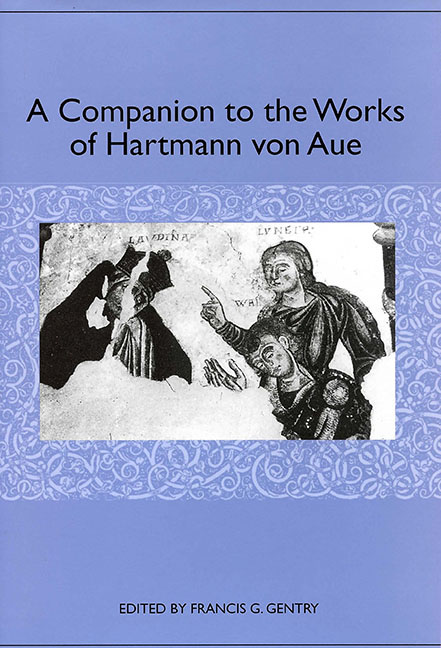Book contents
- Frontmatter
- Contents
- Acknowledgments
- Introduction
- Hartmann's Theological Milieu
- Hartmann von Aue as Lyricist
- Hartmann von Aue and Chrétien de Troyes: Respective Approaches to the Matter of Britain
- Gender and Love in the Epic Romances of Hartmann von Aue
- The Two-Fold Path: Erec and Enite on the Road to Wisdom
- The Body in Pain in the Works of Hartmann von Aue
- Illness and Cure in Hartmann von Aue's Arme Heinrich and Iwein
- Hartmann's Legends and the Bible
- Hartmann's Works in the Visual Arts
- The Medieval Literary Reception of Hartmann's Works
- A Tale of Sacrifice and Love: Literary Way Stations of the Arme Heinrich from the Brothers Grimm to Tankred Dorst
- Editions and Translations of Hartmann's Works
- Works Cited
- Notes on the Contributors
- Index
Gender and Love in the Epic Romances of Hartmann von Aue
Published online by Cambridge University Press: 27 April 2017
- Frontmatter
- Contents
- Acknowledgments
- Introduction
- Hartmann's Theological Milieu
- Hartmann von Aue as Lyricist
- Hartmann von Aue and Chrétien de Troyes: Respective Approaches to the Matter of Britain
- Gender and Love in the Epic Romances of Hartmann von Aue
- The Two-Fold Path: Erec and Enite on the Road to Wisdom
- The Body in Pain in the Works of Hartmann von Aue
- Illness and Cure in Hartmann von Aue's Arme Heinrich and Iwein
- Hartmann's Legends and the Bible
- Hartmann's Works in the Visual Arts
- The Medieval Literary Reception of Hartmann's Works
- A Tale of Sacrifice and Love: Literary Way Stations of the Arme Heinrich from the Brothers Grimm to Tankred Dorst
- Editions and Translations of Hartmann's Works
- Works Cited
- Notes on the Contributors
- Index
Summary
In his workMedieval Listening and Reading: The Primary Reception of German Literature 800–1300, D. H. Green has discussed the phenomenon of thirteenth-century romance as an emergent understanding of fiction and the nature of fictional truth as opposed to historical truth (ch. 9). Chrétien de Troyes set a precedent for his contemporaries at the end of the twelfth century by participating in the new genre and displaying a narrative persona consciously aware of the fiction he was creating. Hartmann von Aue adapted Chrétien's material and themes for his own audiences, not only introducing the “matter of Britain” to his patrons but also (as author and narrator) continuing to develop Chrétien's art and awareness of fiction (Green, 254–55). The fiction of the romance allowed the poet to modify the stories for his audience by focusing on discussion of themes that had particular interest or resonance. The themes of gender and love remained inextricably linked at the center of these discussions. Indeed, Simon Gaunt argues compellingly that gender discussions are constitutive of the romance genre — discussions of what it means to be male and what it means to be female, of what defines masculine and what defines feminine, which are framed in romance in ways that epic could not accommodate (75).
According to Judith Butler and others, gender is performative: it is both relational, mobile, and negotiable (Butler, 24–25), qualities which enable it to function as “a culturally specific process of becoming” (Cohen and Wheeler, xi). This process of becoming, an integral part of the romance (and particularly of the German Arthurian romances by Hartmann von Aue and Wolfram von Eschenbach), offers a series of possibilities to be explored and negotiated throughout any particular narrative, and these negotiations structure an ongoing process of defining gender in a social context, both publicly and privately. As gender is an integral part of social performance, romance poets illustrate the continuous process of defining gender through a variety of roles, emotions and relationships. In the romances of Hartmann von Aue, one concept clearly emerges as the fundamental structuring principle for the development of relationships among the main characters: love. As it takes various forms, such as friendship and loyalty (among men and among women) or minne (between man and woman), the various types of love inform the relationships that, in turn, configure the public and the private spheres.
- Type
- Chapter
- Information
- A Companion to the Works of Hartmann von Aue , pp. 71 - 92Publisher: Boydell & BrewerPrint publication year: 2004

